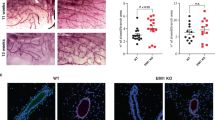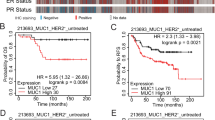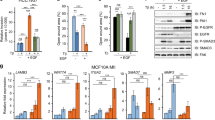Abstract
MUC1 is aberrantly expressed in greater than 90% of all breast carcinomas, yet its function as a tumor antigen is not fully understood. Recently, studies have shown that MUC1 interacts with β-catenin, erbB receptors, src, GSK-3β and protein kinase Cδ, possibly in a complex that promotes the disassembly of adherens junctions and the invasion of cells. Here we show that the deletion of Muc1 expression from MMTV-Wnt-1 transgenic mice results in a significant increase in the time to mammary gland tumor onset. Analysis of MMTV-Wnt-1 tumors on a wild-type Muc1 background shows a tumor-specific complex formation between Muc1 and β-catenin that can be observed in both the membrane and the cytoplasm of transformed epithelium. Analysis of primary human adenocarcinomas revealed that this MUC1/β–catenin interaction occurs in both primary and metastatic tumors, but is dramatically increased in metastatic lesions. Addition of MUC1-cytoplasmic domain peptides to the invasive MDA-MB-468 and MDA-MB-231 cell lines increases their invasive capability, and these peptides colocalize with both β-catenin and the focal adhesion protein vinculin, primarily at sites of membrane invasion into a collagen matrix. These data indicate a potential mechanism for MUC1 promotion of invasive tumorigenesis in the breast through the modulation of β-catenin localization and subsequent cytoskeletal dynamics.
This is a preview of subscription content, access via your institution
Access options
Subscribe to this journal
Receive 50 print issues and online access
$259.00 per year
only $5.18 per issue
Buy this article
- Purchase on Springer Link
- Instant access to full article PDF
Prices may be subject to local taxes which are calculated during checkout






Similar content being viewed by others
References
Adams JC . (1997). Mol. Biol. Cell, 8, 2345–2363.
Biscardi JS, Belsches AP and Parsons SJ . (1998). Mol. Carcinog., 21, 261–272.
Burchell J, Wang D and Taylor-Papadimitriou J . (1984). Int. J. Cancer, 34, 763–768.
Gendler SJ and Spicer AP . (1995). Annu. Rev. Physiol., 57, 607–634.
Hazan RB, Kang L, Whooley BP and Borgen PI . (1997). Cell Adhes. Commun., 4, 399–411.
Hazan RB and Norton L . (1998). J. Biol. Chem., 273, 9078–9084.
He TC, Sparks AB, Rago C, Hermeking H, Zawel L, da Costa LT, Morin PJ, Vogelstein B and Kinzler KW . (1998). Science, 281, 1509–1512.
Hilkens J, Vos HL, Wesseling J, Boer M, Storm J, van der Valk S, Calafat J and Patriarca C . (1995). Cancer Lett., 90, 27–33.
Kondo K, Kohno N, Yokoyama A and Hiwada K . (1998). Cancer Res., 58, 2014–2019.
Li Y, Bharti A, Chen D, Gong J and Kufe D . (1998). Mol. Cell Biol., 18, 7216–7224.
Li Y, Hively WP and Varmus HE . (2000). Oncogene, 19, 1002–1009.
Li Y, Kuwahara H, Ren J, Wen G and Kufe D . (2001a). J. Biol. Chem., 276, 6061–6064.
Li Y, Ren J, Yu W, Li Q, Kuwahara H, Yin L, Carraway III, KL and Kufe D . (2001b). J. Biol. Chem., 276, 35239–35242.
Lin SY, Xia W, Wang JC, Kwong KY, Spohn B, Wen Y, Pestell RG and Hung MC . (2000). Proc. Natl. Acad. Sci. USA, 97, 4262–4266.
McGuckin MA, Walsh MD, Hohn BG, Ward BG and Wright RG . (1995). Hum. Pathol., 26, 432–439.
Michaelson JS and Leder P . (2001). Oncogene, 20, 5093–5099.
Piedra J, Martinez D, Castano J, Miravet S, Dunach M and de Herreros AG . (2001). J. Biol. Chem., 276, 20436–20443.
Rahn JJ, Dabbagh L, Pasdar M and Hugh JC . (2001). Cancer, 91, 1973–1982.
Ren J, Li Y and Kufe D . (2002). J. Biol. Chem., 277, 17616–17622.
Schroeder JA, Adriance MC, McConnell EJ, Thompson MC, Pockaj BA and Gendler SJ . (2002). J. Biol. Chem, 277, 22692–22698.
Schroeder JA, Thompson MC, Gardner MM and Gendler SJ . (2001). J. Biol. Chem., 276, 13057–13064.
Shtutman M, Zhurinsky J, Simcha I, Albanese C, D'Amico M, Pestell R and Ben-Ze'ev A . (1999). Proc. Natl. Acad. Sci. USA, 96, 5522–5527.
Spicer AP, Rowse GJ, Lidner TK and Gendler SJ . (1995). J. Biol. Chem., 270, 30093–30101.
Tao YS, Edwards RA, Tubb B, Wang S, Bryan J and McCrea PD . (1996). J. Cell Biol., 134, 1271–1281.
Tsukamoto AS, Grosschedl R, Guzman RC, Parslow T and Varmus HE . (1988). Cell, 55, 619–625.
Walsh MD, Luckie SM, Cummings MC, Antalis TM and, McGuckin MA . (1999). Breast Cancer Res. Treat., 58, 255–266.
Wesseling J, van der Valk SW and Hilkens J . (1996). Mol. Biol. Cell, 7, 565–577.
Wesseling J, van der Valk SW, Vos HL, Sonnenberg A and Hilkens J . (1995). J. Cell Biol., 129, 255–265.
Yamamoto M, Bharti A, Li Y and Kufe D . (1997). J. Biol. Chem., 272, 12492–12494.
Yamashiro S, Yamakita Y, Ono S and Matsumura F . (1998). Mol. Biol. Cell, 9, 993–1006.
Zotter S, Hageman PC, Lossnitzer A, Mooi WJ and Hilgers J . (1988). Cancer Rev., 111, 55-101.
Zrihan-Licht S, Baruch A, Elroy-Stein O, Keydar I and Wreschner DH . (1994). FEBS Lett., 356, 130–136.
Acknowledgements
This study was supported by grants from the NIH, CA64389 (to SJG), CA81703 (to JAS) and CA90204 (to MCA). We are grateful to Dr Robert Cardiff (University of California – Davis, Davis, CA, USA) for pathological analysis of mouse tissues. We thank Marvin H Ruona for computer graphics, Jose Luis for statistical analysis and the Mayo Clinic Hospital Surgical Pathologists for human tissue procurement and pathological analysis and Carol Williams for administrative assistance.
Author information
Authors and Affiliations
Corresponding author
Rights and permissions
About this article
Cite this article
Schroeder, J., Adriance, M., Thompson, M. et al. MUC1 alters β-catenin-dependent tumor formation and promotes cellular invasion. Oncogene 22, 1324–1332 (2003). https://doi.org/10.1038/sj.onc.1206291
Received:
Revised:
Accepted:
Published:
Issue Date:
DOI: https://doi.org/10.1038/sj.onc.1206291
Keywords
This article is cited by
-
Metastasis organotropism in colorectal cancer: advancing toward innovative therapies
Journal of Translational Medicine (2023)
-
Biodegradable PEG-PCL Nanoparticles for Co-delivery of MUC1 Inhibitor and Doxorubicin for the Confinement of Triple-Negative Breast Cancer
Journal of Polymers and the Environment (2023)
-
MUC1 is a potential target to overcome trastuzumab resistance in breast cancer therapy
Cancer Cell International (2022)
-
Tumor-originated pH-responsive nanovaccine mixture to treat heterogeneous tumors
Journal of Pharmaceutical Investigation (2022)
-
Peritoneal Metastases in Colorectal Cancer: Biology and Barriers
Journal of Gastrointestinal Surgery (2020)



